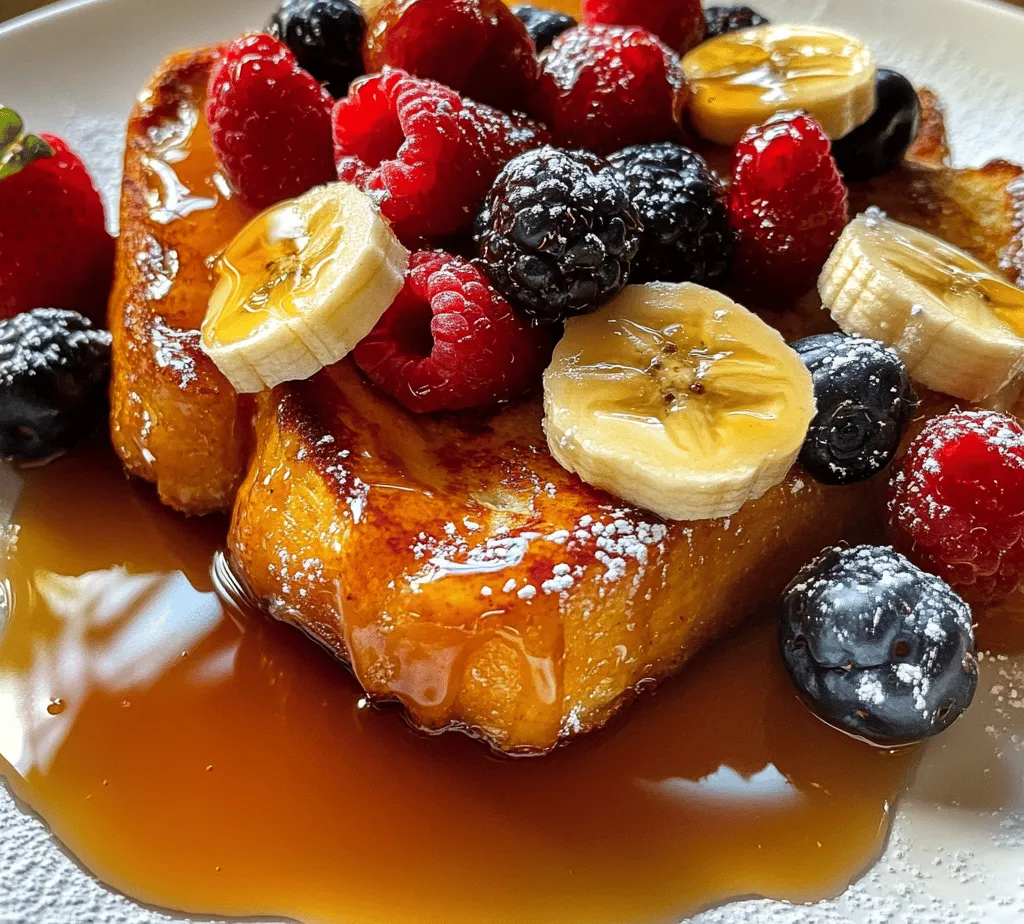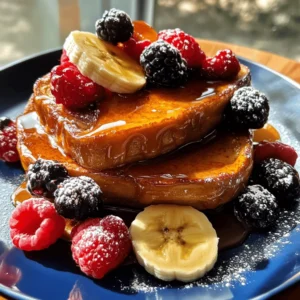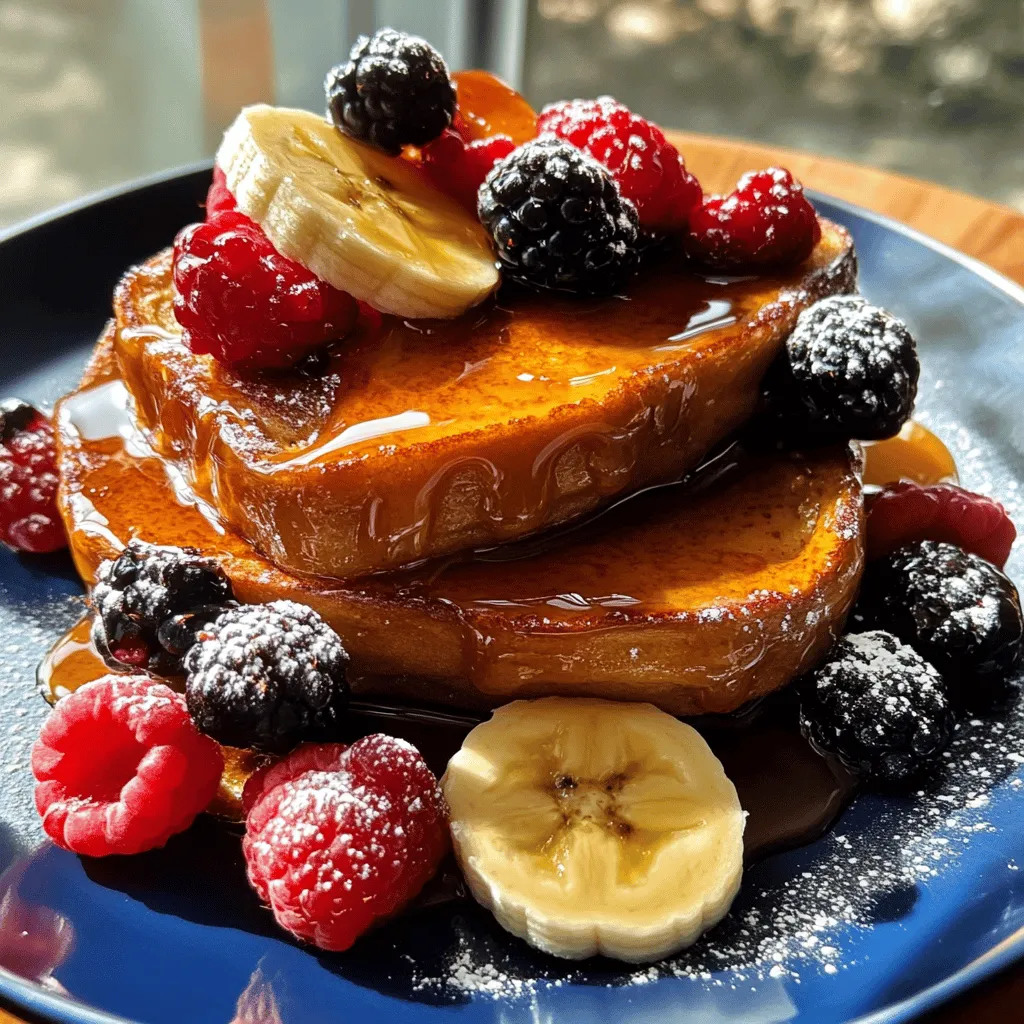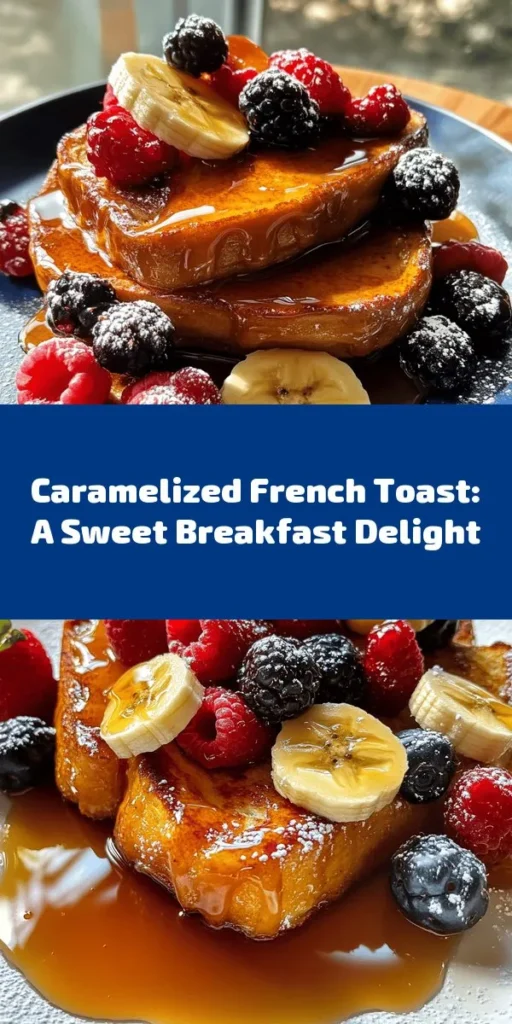Introduction
French toast is a beloved breakfast staple enjoyed by many around the world. Originating from the need to utilize stale bread, this dish has transformed from a simple necessity into a gourmet delight that graces breakfast tables at home and in restaurants alike. Caramelized French toast, in particular, stands out with its rich flavors and delightful texture, elevating the traditional recipe to new heights. The luxurious sweetness combined with the comforting familiarity of French toast creates a dish that is both satisfying and indulgent.
What makes caramelized French toast so appealing is not just its flavor but also its ease of preparation. With just a handful of ingredients and minimal effort, you can whip up a dish that feels special enough for a weekend brunch or a holiday breakfast yet simple enough for a busy weekday morning. In this article, we will explore the origins of French toast, delve into the specifics of the ingredients used in our easy caramelized French toast recipe, and guide you through the initial steps to create this delicious dish.
Understanding French Toast
The history of French toast dates back centuries, with roots tracing back to ancient Rome. The Romans would soak bread in a mixture of milk and eggs, frying it until golden brown—a practice that not only made use of stale bread but also created a delicious dish that could be enjoyed sweet or savory. Over time, this method of preparing bread spread across Europe and was embraced by various cultures, each adding their own twist to the recipe.
In France, the dish became known as “pain perdu,” which translates to “lost bread,” a nod to the use of leftover bread that might otherwise go to waste. It wasn’t until the dish made its way to America that it gained the iconic title of “French toast.” Today, French toast can be made using a variety of breads, with each type contributing its unique flavor and texture to the final dish.
Popular choices for French toast include brioche, challah, sourdough, and even whole-grain varieties. Brioche, with its rich buttery flavor and soft texture, is a favored choice that creates an indulgent experience. Challah, a traditional Jewish bread, adds a slightly sweet flavor and a beautiful golden color when cooked. The versatility of French toast allows for creativity in selecting the perfect bread to suit your taste.
The basic components of French toast typically include eggs, milk, and bread. The eggs serve as a binding agent, enriching the mixture and providing a custardy texture, while the milk adds creaminess. French toast is often flavored with spices like cinnamon and vanilla, which enhance the overall flavor profile. The result is a warm, comforting dish that can be enjoyed plain or dressed up with toppings such as syrup, fruits, or whipped cream.
Ingredients Breakdown
Understanding the ingredients used in our easy caramelized French toast is essential to achieving the perfect balance of flavors and textures. Each ingredient plays a crucial role in creating this delectable breakfast dish.
Thick Bread
The choice of bread is pivotal when making French toast. Thick slices are essential, as they allow for better absorption of the custard mixture without falling apart during cooking. Look for bread with a sturdy crust and a soft, pillowy interior. Brioche is often the go-to choice for its rich flavor and delicate crumb, but challah, sourdough, or even Texas toast can be excellent alternatives. The bread’s flavor and texture significantly influence the final dish, making it crucial to choose wisely.
Eggs
Eggs are the heart of the custard mixture, providing both structure and richness. They bind the ingredients together and create a creamy, custardy texture that is characteristic of well-made French toast. For best results, use large eggs, and ensure they are fresh to enhance the flavor and overall quality of the dish.
Whole Milk
Whole milk contributes to the creaminess of the batter, ensuring that each slice of bread is well-soaked and flavorful. The fat content in whole milk creates a rich custard that enhances the overall mouthfeel of the French toast. While you can substitute with lower-fat milk or plant-based alternatives, using whole milk is recommended for the best results.
Vanilla Extract
Vanilla extract adds a warm, inviting flavor that elevates the overall taste of the caramelized French toast. It complements the sweetness of the dish and works harmoniously with the other ingredients. For a more pronounced vanilla flavor, consider using pure vanilla extract rather than imitation vanilla, as the latter may lack depth and complexity.
Ground Cinnamon
Ground cinnamon is a classic spice used in many breakfast dishes, and it lends a warm, comforting aroma to the caramelized French toast. Its slightly sweet and spicy notes enhance the flavors of the dish and create a familiar taste that many people love.
Butter and Brown Sugar
The combination of butter and brown sugar is what makes caramelized French toast truly special. When heated, the butter creates a rich base for cooking the bread, while the brown sugar caramelizes into a sweet sauce that coats the slices. This caramelization process adds a delightful crunch and depth of flavor, making each bite a heavenly experience.
Maple Syrup and Fresh Fruit
While the caramelized French toast is delicious on its own, serving it with maple syrup and fresh fruit can elevate the dish even further. The natural sweetness of maple syrup complements the caramelized flavors, while fresh fruit adds a refreshing contrast and a pop of color to the plate. Popular options include sliced bananas, berries, or even a sprinkle of nuts for added texture.
With these ingredients in mind, you are well on your way to creating an incredible caramelized French toast that is sure to impress. In the next section, we will delve into the step-by-step instructions for preparing this delightful dish, allowing you to savor the rich flavors and textures that make caramelized French toast a breakfast favorite.

Step-by-Step Instructions
Preparing the Egg Mixture
The foundation of a perfect French toast lies in the egg mixture. Start by cracking four large eggs into a mixing bowl. Using a whisk or a fork, beat the eggs until they are well combined. You want to achieve a smooth, homogenous mixture where the yolks and whites are fully integrated. This step is crucial for ensuring that the French toast has a rich, custardy texture.
Next, gradually add in one cup of milk. Whole milk works beautifully for a creamier texture, but you can also substitute with almond milk or any other dairy alternative if you prefer. For added flavor, mix in a teaspoon of vanilla extract and a pinch of salt. The vanilla adds a lovely aroma, while the salt enhances the overall flavors. Whisk the mixture again until everything is well blended. The consistency should be slightly thicker than regular milk but still pourable—this will help the bread soak up just the right amount without becoming overly soggy.
Caramelizing Sugar
Once your egg mixture is ready, it’s time to prepare the star of this recipe: the caramelized sugar. In a medium skillet, add half a cup of granulated sugar over medium heat. Allow the sugar to melt slowly, stirring gently with a wooden spoon. It’s important to keep an eye on the sugar during this process. You’ll notice it starting to clump together before it begins to liquefy.
The key signs that your sugar is caramelizing correctly include a change in color from white to a light amber hue. This process usually takes about 5 to 7 minutes, depending on your stovetop heat. Be cautious, as sugar can go from perfectly caramelized to burnt quickly. If you notice any dark spots forming, reduce the heat immediately. Once the sugar has melted into a smooth, golden syrup, remove it from the heat to prevent further cooking.
Dipping the Bread
Now that your caramel sauce is ready, it’s time to prepare the bread. Choose a thick-cut bread, such as brioche or challah, which will absorb the custard mixture without falling apart. Slice the bread into 1-inch thick pieces.
To dip the bread, take each slice and immerse it into the egg mixture. Ensure that both sides are coated, but avoid oversaturating them. A quick dip is sufficient—about 5 seconds on each side should do the trick. This method allows the bread to soak up just the right amount of the egg mixture, resulting in a fluffy yet slightly firm texture when cooked.
Cooking the Toast
Now comes the exciting part—cooking the French toast. Heat a non-stick skillet or griddle over medium heat and add a tablespoon of butter. Once the butter has melted and begins to bubble, place the dipped bread slices in the skillet. You should hear a satisfying sizzle as the bread makes contact with the hot surface.
Cook each slice for about 3-4 minutes on the first side, or until golden brown. Flip the slices carefully using a spatula, taking care not to disturb the caramelized sugar. Cook for an additional 3-4 minutes on the other side until it achieves the same golden color. Repeat the process with the remaining slices, adding more butter to the skillet as needed.
Serving Suggestions
To serve your Easy Caramelized French Toast, start by stacking the golden-brown slices on a large plate. Drizzle some of the leftover caramel sauce over the top for an extra touch of sweetness. You can also dust the toast with powdered sugar for a classic presentation that looks as delightful as it tastes.
For added flavor and texture, consider garnishing the dish with fresh fruits like sliced strawberries, blueberries, or bananas. A dollop of whipped cream can elevate the dish, making it feel indulgent. If you want to add a touch of sophistication, sprinkle some crushed nuts, such as pecans or walnuts, over the top. Each of these toppings not only enhances the visual appeal but also adds delightful flavors and textures to complement the caramelized toast.
Nutritional Information
When it comes to breakfast, Easy Caramelized French Toast can be a delicious choice, but it’s also important to consider its nutritional value. This recipe, serving four, contains approximately:
– Calories: 350 per serving
– Protein: 10 g
– Fat: 12 g
– Carbohydrates: 50 g
– Fiber: 2 g
– Sugar: 20 g
The primary source of protein comes from the eggs, while the bread provides carbohydrates and some fiber. The addition of fruits as toppings can increase the fiber and vitamin content of the meal, making it more balanced.
Despite the sugar content from the caramelization, French toast can fit into a balanced breakfast when enjoyed in moderation. Pairing it with a side of fresh fruit and a protein source, like yogurt or scrambled eggs, can create a more nutrient-dense meal, helping to keep you feeling full longer.
Variations and Customizations
One of the wonderful aspects of French toast is its versatility. While this recipe provides a delicious foundation, feel free to customize it to suit your taste preferences. Here are some variations you might consider:
1. Spices: Add a pinch of cinnamon, nutmeg, or cardamom to the egg mixture for a warm, aromatic twist. These spices complement the sweetness of the caramel and add depth to the flavor.
2. Type of Bread: While brioche and challah are fantastic choices, you can experiment with different types of bread. Sourdough offers a tangy flavor, while whole grain bread can add a nutty taste and additional fiber.
3. Toppings: Explore various toppings beyond fruits and whipped cream. Consider adding a drizzle of maple syrup, flavored yogurt, or even chocolate chips for an indulgent treat.
4. Stuffed French Toast: For a richer experience, consider stuffing your French toast. Spread a layer of cream cheese, Nutella, or peanut butter between two slices before dipping them in the egg mixture. This will create an ooey-gooey center that is sure to impress.
5. Savory Twist: If you prefer a savory breakfast, try omitting the sugar in the caramelization step and instead add herbs or cheeses in the egg mixture. Top with sautéed vegetables or a poached egg for a unique take on French toast.
The Joy of Cooking Together
Cooking can be a delightful bonding experience, and making Easy Caramelized French Toast is no exception. Involving family or friends in the preparation can transform a simple breakfast into a memorable occasion. Each step can be shared; from whisking the eggs to caramelizing the sugar, everyone can take part in the process.
This recipe is particularly kid-friendly, as children often enjoy dipping the bread and watching the magic of cooking unfold. The kitchen becomes a space of laughter and sharing stories as everyone anticipates the delicious outcome.
Moreover, cooking together fosters a sense of teamwork and creativity, allowing each person to contribute their ideas and preferences. Whether it’s choosing toppings or experimenting with spices, the collaborative nature of cooking can enhance relationships and create lasting memories.
Conclusion
In summary, Easy Caramelized French Toast is not only a simple and delicious breakfast option but also a versatile dish that invites creativity in the kitchen. With its rich, custardy texture and the sweet touch of caramel, it promises to be a hit with family and friends.
This recipe encourages not just cooking but also connection, turning breakfast into a shared experience that can be enjoyed together. Embrace the joy of making this delightful dish, and don’t forget to make it your own with various toppings and flavors. So gather your loved ones, whip up this Easy Caramelized French Toast, and savor the delicious moments created around the breakfast table. Enjoy your culinary adventure!



